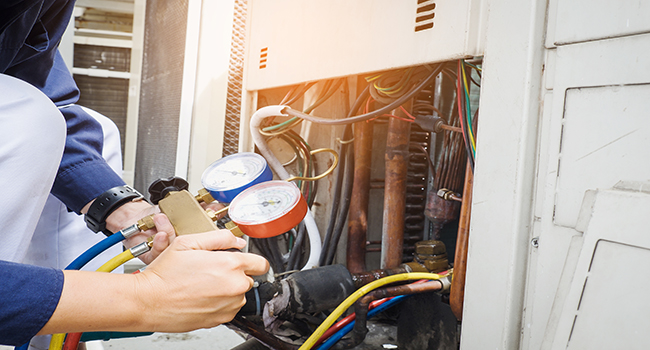
4 Ways Schools Can Improve Indoor Air Quality to Reduce COVID-19 Transmission
- By Ben Thompson
- September 29, 2020
While COVID-19 is believed to be primarily transmitted via close contact with infected persons, growing evidence suggests that the virus can remain airborne for longer periods of time and over greater distances.
Today, more than ever, air quality matters. A building’s HVAC technology can help decrease the transmission rate or mitigate the risk of exposure. Thus, schools must consider their HVAC system as part of their overall COVID-19 mitigation strategy, in addition to social distancing, cleaning, screening, signage and operational practices.
COVID-19 has exposed a chronic concern when it comes to schools and the learning environment: the quality of the learning environment is directly tied to student outcomes, both mentally and physically. Schools vary greatly in terms of their age, the type of HVAC systems operating, and the quality of the indoor environment.
To determine the state of a school’s HVAC system — and its readiness to mitigate COVID-19 — consider the following questions:
- Does the school meet today’s indoor air quality requirements as defined by current code standards and guidance given during the COVID-19 pandemic? If not, where do the deficiencies lie?
- Do today's code standards dramatically decrease the transmission of infectious diseases broadly, and COVID-19 specifically? If not, why?
- How do we improve air quality immediately to combat COVID-19 exposure and transmission?
- How do we improve the learning environment holistically to offer equitable environments across communities, regions, and states?
By delving into the answers to these questions, a strategy can be developed to improve a school building’s ventilation and air filtration as part of a larger COVID-19 mitigation strategy.
School administrators looking for answers should start with these four strategies:
1. Assess your current system
A critical first step is to assess your current system. A well-performing system introduces clean air, removes contaminated air and ventilates and dilutes indoor air contaminants.
As every system is unique, consult with an engineer to test your current HVAC system’s compliance with ASHRAE’s COVID-19 building readiness/reopening guidance.
The engineer should assess the following against the current recommendations:
- Ventilation and exhaust system
- Fresh air intake rate and conditioning
- Maintenance schedules for the mechanical system
- Mechanical control sequences
Individual schools differ widely on these factors because of the age of the system and type of system installed. Depending on the findings, recommended mitigation strategies may include adjusting the mechanical control sequences and upgrading or installing new filtration media and retrofitting equipment.
With the facts about a system established, solutions can be given in terms of cost and schedule. As schools and districts return to the classroom, a priority will be given to mitigation solutions that offer the most immediate results without disruption to the learning environment.
2. Deep clean your HVAC system by flushing it
Just as schools are deep cleaning their physical spaces in preparation for students’ return, they should also deep clean their HVAC systems by flushing them out to remove existing contaminants.
While a three-day flush-out period to flush out 100% of outside air is recommended, this is dependent on geography and climate, your building envelope, mechanical system type and interior finishes. An experienced architectural and engineering team can recommend the most appropriate flushing regime for your facility.
After a flush-out is complete, conduct regular testing to monitor contamination levels and disinfectant concentrations.
3. Change and upgrade filters
Regular filter replacement is critical to maintaining a healthy HVAC system. When replacing used filters, consider increasing the level of filtration to the maximum level your system can support. To reduce small particulates that may carry COVID-19, you should ideally use MERV 13 filters with MERV 8 pre-filters.
The thicker and denser the filter, the more effective it is. However, thicker filters make your HVAC system work harder, leading to decreased efficiency and increased maintenance requirements. An engineer can help you strike a balance between higher filtration and over-taxing your system.
Consider other air-cleaning technologies, including UV filtration and bipolar ionization. While the up-front costs are higher than simply changing out filters, this can be an affordable option for systems that cannot accommodate larger filters (which can be the case with older systems). These types of systems have lasting effects for the learning environment past COVID-19. When schools and districts consider their longer-term strategy for improving schools, these options should be part of the discussion to better improve the air quality and decrease transmission of multiple bacterial and viral pathogens.
4. Use the outdoors
Healthy fresh air isn’t solely the domain of mechanical engineers and HVAC systems. Offering and encouraging the use of the outdoors as a space for instruction decreases the “viral load” of a facility, but also, by all available evidence, reduces transmission of infectious disease. When done well, it also keeps students engaged and active in learning. This is largely driven by the season and the climate, so planning it important. Providing more covered areas, outdoor seating options, and services can greatly extend indoor learning to the outdoors.
In some climates, the simplest and most effective intervention is to work with an architect to design your space for natural ventilation, from operable windows that you can open to punching holes deep in floor plates. A natural approach, even when it involves a significant retrofit, can be healthier in the long run. Closely coordinate this with your existing building’s mechanical system and controls. Indoor air quality will be directly influenced by the climate. Hot and humid environments respond very differently in comparison to cool and dry climates.
The goal of these design strategies is to deliver the best results for students and teachers to protect their communities. The strategies are borne from a wealth of experience assisting school systems in analysis, strategies for short- and long-term improvements, and exceptional learning environment design for students in the 21st century.